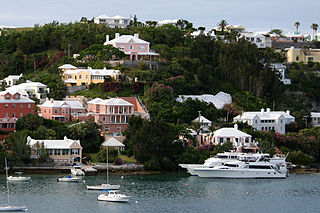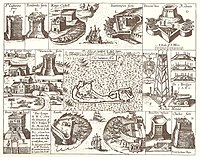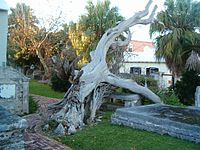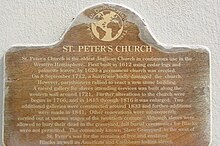
Bermuda is a British Overseas Territory in the North Atlantic Ocean. The closest land outside the territory is in the American state of North Carolina, about 1,035 km (643 mi) to the west-northwest.

A parish church in Christianity is the church which acts as the religious centre of a parish. In many parts of the world, especially in rural areas, the parish church may play a significant role in community activities, often allowing its premises to be used for non-religious community events. The church building reflects this status, and there is considerable variety in the size and style of parish churches. Many villages in Europe have churches that date back to the Middle Ages, but all periods of architecture are represented.

A chapel of ease is a church building other than the parish church, built within the bounds of a parish for the attendance of those who cannot reach the parish church conveniently, generally due to distance away.

St. George's, located on the island and within the parish of the same names, settled in 1612, is the first permanent English settlement on the islands of Bermuda. It is often described as the third permanent British settlement in the Americas, after Jamestown, Virginia (1607), and Cupids, Newfoundland (1610), and the oldest continuously-inhabited British town in the New World, since the other two settlements were seasonal for a number of years.

Sir Richard Christopher Sharples, was a British politician and Governor of Bermuda who was shot dead by assassins linked to a small militant Bermudian Black Power group called the Black Beret Cadre. The former army major, who had been a Cabinet Minister, resigned his seat to take up the position of Governor of Bermuda in late 1972. His murder resulted in the last executions conducted under British rule.

Castle Harbour is a large natural harbour in Bermuda. It is located between the northeastern end of the main island and St. David's Island. Originally called Southampton Port, it was renamed as a result of its heavy fortification in the early decades of the Seventeenth century.

St. George's Island is one of the main islands of the territory of Bermuda and lies within St. George's Parish at the East End of the archipelago. St. George's Town, the original colonial capital, is located on the southern shore near the eastern end of the island. The island covers 703 acres, and is one of the six principal islands of Bermuda.

The governor of Bermuda is the representative of the British monarch in the British overseas territory of Bermuda.
Government House is the official residence of the governor of Bermuda. It is located on Langton Hill, overlooking the North Shore in Hamilton, Pembroke. Government House is also the official residence of the Bermudian head of state when staying in Bermuda.

The architecture of Bermuda has developed over the past four centuries. The archipelago's isolation, environment, climate, and scarce resources have been key driving points, though inspiration from Europe, the Caribbean and the Americas is evident. Distinctive elements appeared with initial settlement in the early 17th century, and by the second half of that century features that remain common today began to appear.

Several of the islands strung across the South entrance of Castle Harbour, Bermuda were fortified in the early days of the territory, hence the harbour's name. When official settlement of the archipelago by England began in 1612 the first permanent town, St. George's was placed on the North side of St. George's Harbour. St. George's Harbour could be accessed directly by channels from the East. Those channels, however, were shallow, suitable, originally, only for small ships. As a consequence, and despite any major settlement on its shores, Castle Harbour was an important anchorage in the early years of the colony, with its main entrance, Castle Roads being an important route in from the open Atlantic for shipping. It was also a weak point, as it was remote from the defences of St. George's Harbour, and difficult to reach. It was quickly fortified and garrisoned by a standing militia.

The State House (1620) in St. George's was the first purpose-built home of the House of Assembly, which then constituted the only chamber of the Parliament of Bermuda. Other than fortifications, it was Bermuda's first stone building. It is the oldest surviving Bermudian building, again excepting some fortifications, and has been used since 1815 as a Masonic lodge.

The Anglican Church of Bermuda is a single diocese consisting of nine parishes and is part of the Anglican Communion, though not a part of an ecclesiastical province. The current Bishop of Bermuda, seated at the Cathedral of the Most Holy Trinity in the City of Hamilton, is Nicholas Dill, who was installed on 29 May 2013.

The Cathedral of the Most Holy Trinity is an Anglican cathedral located on Church Street in the City of Hamilton, in Pembroke Parish, in the British Overseas Territory of Bermuda.

Lieutenant-Colonel George James Bruere was a British Army officer and colonial administrator who served as governor of Bermuda from 1764 until his death in 1780. Of all Bermuda's governors since 1612, his term of office was the longest. He had a difficult time during the American Revolutionary War and is thought to have died of chronic stress caused by the interplay of Bermudians and American rebels.

The Historic Town of St George and Related Fortifications is the name used by the United Nations Educational, Scientific and Cultural Organization's (UNESCO) World Heritage Committee to identify collectively as a World Heritage Site St. George's Town, founded in 1612, and a range of fortifications, batteries, and magazines built between 1612 and 1939, the last of which was removed from use in 1953.

St John's Anglican Church is an Anglican church located in New Town, Tasmania, Australia, is notable for its unbroken record of use as a parish church, from the first service on 20 December 1835 up to the present. The parish is administered by the Anglican Diocese of Tasmania.

St Peter's Anglican Church is a heritage-listed Anglican church and associated Sunday school, rectory, and cemetery at 384 Windsor Street, Richmond, City of Hawkesbury, New South Wales, Australia. It was designed by Francis Clarke and Edmund Blacket and built from 1836 to 1841 by James Atkinson (church). It is also known as St Peter's Anglican Church Group, St Peter's Church Group, Church, Rectory, Church Yard, Cemetery and Stables. It was added to the New South Wales State Heritage Register on 16 August 2019; and on the City of Hawkesbury local government heritage register, and listed on the New South Wales Heritage Database on 12 September 2012.

The Old Devonshire Church is an Anglican parish church of Devonshire in Bermuda. It was established in the 1620s but has been rebuilt several times after various disasters. The original church included a ship construction style that reflected original Bermudian architecture informed by the maritime industry endemic to the island. It was destroyed by a hurricane and rebuilt in 1716 and again after a fire in 1970. The present structure is constructed in a cruciform design, with limestone walls and cedar joists.
Joseph Stockdale was the publisher of Bermuda's first newspaper, the The Bermuda Gazette, a Bermudian English-language weekly newspaper. It was published from 1784 to 1803 by Stockdale ; In 1782, the Bermudian Legislature arranged for a printing press, and brought Stockdale from England to run it. He had been given financial incentive to move to Bermuda with his family and establish the newspaper.






















